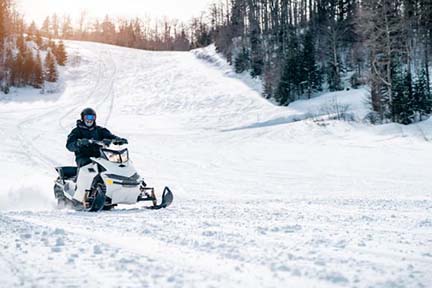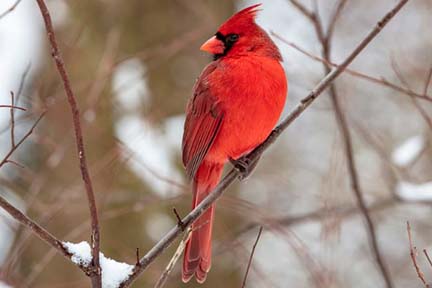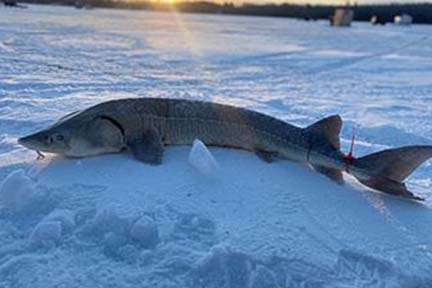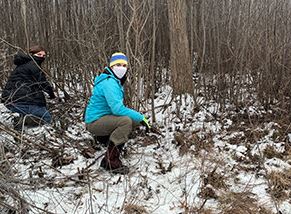Counting down the year
“I’m traveling light because I might be going far, taking nothing but the clothes on my back and this big red guitar, I’m just restless,” – Carl Perkins
By JOHN PEPIN
Deputy Public Information Officer
Michigan Department of Natural Resources
In the darkness of this place, I can hear the clock ticking from the adjacent room. The sound is stark and commanding in its repetition.
From where I am sitting, the passing of the seconds marked by the second hand clicking forward is the only sound I can hear.
To me, the noise signifies the running down of time remaining in this old and very tired year of seemingly endless and staggering challenges. Like so many others, I am excited to turn the page to a new and fresh set of days ahead.
Right now – on this side of the new year – those days hold promise, hope and optimism I am happy to reach for – like a lifeline cast to those flailing in icy waters around an overturned boat.
For me, this past year has led me to focus on simplicity wherever I can find it.
After a few days of thinking about that idea, I discovered a great deal of superfluous stuff all around me, seemingly packed into every small crevice of just about anything –even conversations, relationships.
It makes me nauseous to think about for too long. Time wasted. Tick. Tock.
I’ve got an old-time brass compass that is small enough, and light enough, to fit into any of my pockets when I head for the woods. It doesn’t do anything beyond point out magnetic north and the four associated directions, relative to my position.
That is all it is supposed to do.
It’s very simple and unpretentious, but highly functional.
I have realized that I am thirsting to surround myself with things uncomplicated – from my little pocket compass to matters stated clearly, intentions, motives and directions easy to read.
In short, I want to pare things down to the things that matter most.
I think that in doing so, I will find new freedoms and truer vision moving forward.
Nature is often my key, my treasure map, to greater understanding.
Getting “out there” to walk, even for a short time, often does wonders to pull away layers of confusion, sorrow or frustration to often reveal a divine clarity.
It’s like being able to breathe again after blowing my nose.
Some good examples of devices nature uses to produce this effect include the sound of rain, the sight of watching the currents of a river swirling and stretching, the smell of spring cherry blossoms or ripe August blueberries, or the feeling of warm and delicious summer breezes across my face at a sandy beach.
To enhance most of these effects, I close my eyes.
That may also explain my affinity for dark rooms – they often magnify my senses, and they also take away the clutter, making it easier to reason and relax.
I noticed the joy of simplicity yesterday, just filling my bird feeders and watching the birds gather around me.
The black-capped chickadees are the least shy. I often wonder why that is.
Red-breasted nuthatches are a close second. They love peanut butter and will eat it off a spoon held in my hand.
If I whistle their song, the chickadees arrive in short order. The short fluttering sound of their wings as they move back and forth, just inches away, is a favorite of my wife and our girls.
After the feeders are filled and we step back to go inside the house, those birds that have watched from a distance now readily swoop in.
A red-bellied woodpecker and a blue jay both use their bills to break away chunks of suet, which they fly away with to eat elsewhere.
After a ceremonious loud fluttering entrance, a half dozen mourning doves calmly gather on the ground beneath the feeders, where they begin picking up seeds, bobbing their heads.
The birds have various bill types and other adaptations, depending on their needs – seed cracking, probing, insect catching, meat-tearing. Different styles of flight are common, as are variations in perching fashion and a range of other behaviors.
After dark, flying squirrels will find the feeding station. They will eat the black-oil sunflower seeds and devour the suet.
How all these things come together to happen may be very complicated, but it doesn’t seem so. It appears to all fit together properly and completely, while at the same time, change is still working in the background, tinkering.
Change is one of the chief engineers driving the locomotive of progress, but it also presents complications and confusion, sometimes even chaos.
However, that’s not to say change is bad.
Without the promise and possibility of change, hope often withers.
Change is also another exciting aspect of nature for me.
I love that, while I might be able to predict a general possibility of based on past events, like seeing a moose in a particular area, one of the best things about experiencing the outdoors is that I never know exactly what I might see.
Every time I go out, something different is likely to happen. In addition, the possibility that something will happen that has never occurred before also exists. These realities help make getting outside an exciting and rewarding experience.
On the surface, these adventures may seem dull or even mundane by simple description, but they are far from that. They are feasts for the senses and new things to encounter, experience and enjoy.
The happenings that occur on my nature outings tend to imprint themselves on my memory, often for decades to come. I can remember clearly numerous firsts, like the first time I saw a spotted owl or heard a wolf howl.
I recall roads for the bridges they have on them, the creeks that cross under them, the consistency of their composition – two-track, pavement, railroad gravel, dirt – or where they will bring me to or from.
Despite all the things I have learned from nature and about nature, there is a whole universe of discovery out there that remains.
With the new year approaching, I’m riding in the back of a phantom carriage that will take me across the line. Despite my faults, misgivings and fears, I will go along willingly into that new calendar of the undetermined.
I hope to bring with me more of what I need, discarding those unnecessary provisions that will only weigh me down and keep me from traveling lighter and being more certain of my footing.
I’ll be bringing my compass. A pocket watch, knife and warm coat. My boots on my feet and a map, a notebook and a pen. I can put most of all that in a knapsack I can throw around my shoulder.
With a sweet Auld lang syne and a heart full of soul, I’ll climb the switchbacks up to a pine-treed saddle. There, I’ll turn around and nod back a fond farewell.
Then I’ll take in the view, draw a deep breath of crisp mountain air and start my descent down the other side. In a few days, I’ll be along the rivers twisting through the depths of an unfamiliar valley.
Like Ptolemy and Lewis and Clark, I’ll begin my trek into terra incognita – the unknown territory. One step at a time.
Check out previous Showcasing the DNR stories at Michigan.gov/DNRStories. To subscribe to upcoming Showcasing articles, sign up for free email delivery at Michigan.gov/DNREmail.
Note to editors: Contact: John Pepin, Showcasing the DNR series editor, 906-226-1352. This column was previously published as a column in the Outdoors North series in the Upper Peninsula. An accompanying photo and a text-only version of this story are available below for download. Caption information follows. Credit Michigan Department of Natural Resources, unless otherwise noted.
Text-only version of this story.
Pepin_IMG_4568: An image of a Marquette County lake reflects the passage of time and the changing of the seasons. (John Pepin photo) |














